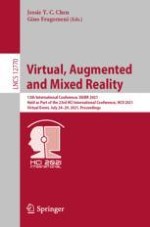2021 | Buch
Virtual, Augmented and Mixed Reality
13th International Conference, VAMR 2021, Held as Part of the 23rd HCI International Conference, HCII 2021, Virtual Event, July 24–29, 2021, Proceedings
herausgegeben von: Jessie Y. C. Chen, Gino Fragomeni
Verlag: Springer International Publishing
Buchreihe : Lecture Notes in Computer Science
